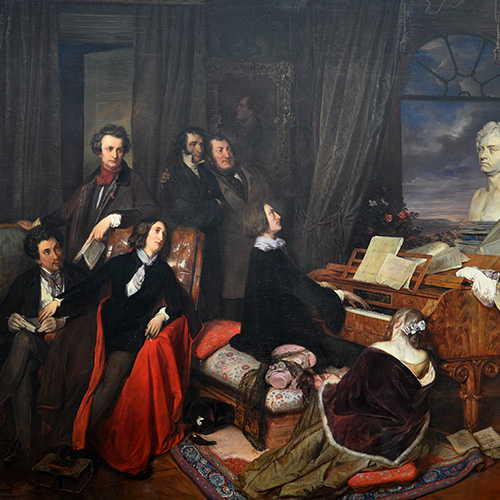
Franz Liszt Fantasizing at the Piano by Josef Danhauser, 1840
Popular speaker and concert pianist Rachel Franklin returns to the fascinating topic of concertos with a follow-up 4-session course to her fall 2022 Smithsonian Associates exploration of this most glamorous form of musical display.
A superb concerto performance is one of the great emotional highs of the concert experience. Concertos can be intimate, grand, virtuosic, or downright gladiatorial. Little can beat the adrenaline rush that we feel when the soloist thunders at top speed towards a colossal musical peak, with the orchestra surging massively just behind. (Just think Rachmaninoff.) But how did this singularly theatrical art form evolve, and why does it remain as treasured as ever with audiences?
Franklin uses her unique live piano demonstrations and both historical and contemporary video clips to explore the birth of the solo concerto, glory in its great masterpieces, and consider its role in more modern times.
British-born Franklin has been a featured speaker for organizations including the Library of Congress and NPR, exploring intersections among classical and jazz music, film scores, and the fine arts.
October 26 Early Masters
Franklin offers a brief survey of the concerto's origins, with emphasis on the glorious inspirations of Antonio Vivaldi and J. S. Bach. Works include Vivaldi’s groundbreaking violin concertos and several of Bach’s mighty landmarks, such as his Brandenburg Concertos and various solo concertos.
November 2 Classical Perfection
We owe our modern-day conception of concerto to Mozart’s magnificent body of piano concertos, composed mostly for his own use and to establish his unique piano “brand.” Franklin surveys a selection of these in tandem with the development of the piano. She also demonstrates Beethoven’s Mozartian inheritance and the role of improvisation in their works. Works include Mozart’s C Minor Concerto, K. 491 and Beethoven’s Concertos Nos. 1 and 4.
November 9 The Glory of Virtuosity
There's a good reason why the majestic crowd-pleasers continue to be programmed in our concert halls. Dazzling display allies itself with profound emotional pull as composers in the Romantic era—Chopin, Liszt, Paganini, Brahms, Tchaikovsky, and Dvorak among dozens of others—provide a platform for musical superstardom throughout the 19th century and beyond. Included are Mendelssohn and Tchaikovsky’s Violin Concertos, Victor Herbert’s Cello Concerto, Rachmaninoff’s Piano Concerto No. 2, Schumann’s Konzertstück for Four Horns, and many others.
November 16 Concertos of Our Time
The 20th century saw an explosion of varied concerto styles and less prominent instruments were finally given opportunities to shine. After showcasing some of the greatest classic 20th-century concertos by masters such as Sibelius, Prokofiev, Barber and others, Franklin discusses how newer concerto writing has embraced world movements like jazz and ethnic music, drawing on Emmanuel Séjourné's Marimba Concerto, Glazunov’s noble Saxophone Concerto and the sizzling Concerto for Clarinet by Artie Shaw.
4 sessions
General Information